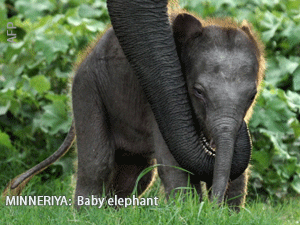
Sri Lanka has the potential to become one of the global hot spots for whale watching as it is among the easiest places in the world to watch blue and sperm whales according to researchers, marine biologists and eco-tourism specialists.
Whale and dolphin watching is a seasonal activity in Sri Lanka, available on the west coast in locations from Kalpitiya and along the South West Coast from November to March while the east coast off Trincomalee is preferable from June to September.
'The Whale and Dolphin Conservation Society estimates that ten million people go whale watching every year,' said Heba AL Ghais AL Mansoori, Middle East Director of Sri Lanka Tourism Promotion Bureau.
'Sri Lanka has the potential to attract several thousand whale watchers on bespoke tours or even to take one off excursions.' Ms. Al Mansoori noted that Sri Lanka is the most reliable and easiest location in which to see the Blue Whale, the largest animal that has ever inhabited this planet.
'Sri Lanka may well turn out to be the top location for seeing both Blue and Sperm Whales,' she said.
Tour operators in Sri Lanka offer both boat and air based expeditions.
For the boat trips, motor boats and trawlers enable the guests to travel far out to sea and get to the natural habitats of the whales and dolphins.
Air based expeditions are also available by helicopter or sea plane for an incredible aerial view of Sri Lanka.
The proximity to the shore makes Sri Lanka one of the easiest places in the world to spot blue or sperm whales.
Blue whales are the largest animals on earth growing up to some 110 feet in length and weighing up to 180 metric tons. They feed on krill, a shrimp like marine invertebrate. Sperm whales, the largest carnivore mammals, mostly feed on squid and octopus in the deep sea bed.
Naturalists say conditions around the island are good for whale habitat due to the nutrient flow from the country's river system. Increased sightings of both blue whales and sperm whales off the southern coast have now opened up a window of opportunity for whale watching tourism in the island's Deep South.
According to marine biologists, the deep sea off Dondra Head is one of the best locations to watch whales in Sri Lanka because of its close proximity to the coast. High concentration of both blue whales and sperm whales within easy reach under tropical conditions puts Sri Lanka on top of the world's whale watching map.
Due to the calm seas, between December and April, there are is an outstanding window of opportunity for observing Blue Whales and Sperm Whales close to shore because of a migration of whales. The South of Sri Lanka is blessed with beautiful beaches, snorkelling and some of the best boutique hotels and villas in the world.
'Sri Lanka has over the centuries been described as a tropical paradise. This is not surprising as it is a destination that has everything: sun, sea, sandy beaches, cool mountains, ancient monuments and lakes, forests teeming with wildlife, precious stones, magnificent archaeological sites and above all friendly people,' remarked Ms Al Mansoori.
Combine this with well educated, English conversant people, and a good tourist infrastructure, and it is not hard to see why it continues to enjoy being a popular tropical island destination.
Sri Lanka offers diversity within easy reach in a small island. Among the many epithets showered upon this tiny island include Serendipity, Ceylon, Teardrop of India, Resplendent Isle, Island of Dharma and Pearl of the Indian Ocean to name a few and none comes even close to articulate the true beauty and old world charm of Sri Lanka.
Tourists from around the world visit Sri Lanka every year in search of a perfect holiday ranging from nature, culture, adventure, education, healing and spiritual discovery to connecting with roots or simply to watch a cricket match.
SriLankan Airlines operates a full Airbus fleet to 41 destinations in 22 countries worldwide. Flights from the Middle East to Colombo connect with onward services to the Maldives, 11 key destinations in India, seven destinations in the Far East including Malaysia, Singapore, China and Thailand.


